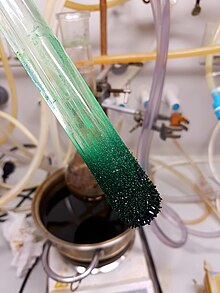
Back Sublimasie Afrikaans Sublimation (Physik) ALS تسام Arabic Sublimación AST Sublimasiya (faza keçidi) Azerbaijani Sublimasyon BCL Сублімацыя (фізіка) Byelorussian Сублимация Bulgarian ঊর্ধ্বপাতন Bengali/Bangla Sublimacija (fizika) BS

Sublimation is the transition of a substance directly from the solid to the gas state, without passing through the liquid state.[1] The verb form of sublimation is sublime, or less preferably, sublimate.[2] Sublimate also refers to the product obtained by sublimation.[2][3] The point at which sublimation occurs rapidly (for further details, see below) is called critical sublimation point, or simply sublimation point. Notable examples include sublimation of dry ice at room temperature and atmospheric pressure, and that of solid iodine with heating.
The reverse process of sublimation is deposition (also called desublimation), in which a substance passes directly from a gas to a solid phase, without passing through the liquid state.[4]
All solids sublime, though most sublime at extremely low rates that are hardly detectable. At normal pressures, most chemical compounds and elements possess three different states at different temperatures. In these cases, the transition from the solid to the gas state requires an intermediate liquid state. The pressure referred to is the partial pressure of the substance, not the total (e.g. atmospheric) pressure of the entire system. Thus, any solid can sublime if its vapour pressure is higher than the surrounding partial pressure of the same substance, and in some cases, sublimes at an appreciable rate (e.g. water ice just below 0 °C).
For some substances, such as carbon and arsenic, sublimation from solid state is much more achievable than evaporation from liquid state and it is difficult to obtain them as liquids. This is because the pressure of their triple point in its phase diagram (which corresponds to the lowest pressure at which the substance can exist as a liquid) is very high.
Sublimation is caused by the absorption of heat which provides enough energy for some molecules to overcome the attractive forces of their neighbors and escape into the vapor phase. Since the process requires additional energy, sublimation is an endothermic change. The enthalpy of sublimation (also called heat of sublimation) can be calculated by adding the enthalpy of fusion and the enthalpy of vaporization.
- ^ Whitten, Kenneth W.; Gailey, Kenneth D.; Davis, Raymond E. (1992). General chemistry (4th ed.). Saunders College Publishing. p. 475. ISBN 0-03-072373-6.
- ^ a b "Sublimate". Merriam-Webster.com Dictionary.
- ^ "Sublimate". CollinsDictionary.com Dictionary.
- ^ Boreyko, Jonathan B.; Hansen, Ryan R.; Murphy, Kevin R.; Nath, Saurabh; Retterer, Scott T.; Collier, C. Patrick (2016). "Controlling condensation and frost growth with chemical micropatterns". Scientific Reports. 6: 19131. Bibcode:2016NatSR...619131B. doi:10.1038/srep19131. PMC 4726256. PMID 26796663.